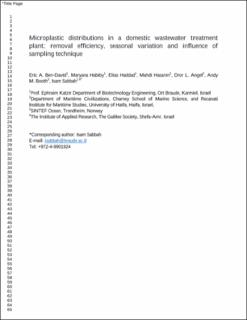| dc.contributor.author | Ben-David, Eric | |
| dc.contributor.author | Habibi, Maryana | |
| dc.contributor.author | Haddad, Elias | |
| dc.contributor.author | Hasanin, Mahdi | |
| dc.contributor.author | Angel, Dror L. | |
| dc.contributor.author | Booth, Andy | |
| dc.contributor.author | Sabbah, Isam | |
| dc.date.accessioned | 2021-10-06T13:40:12Z | |
| dc.date.available | 2021-10-06T13:40:12Z | |
| dc.date.created | 2020-09-14T17:41:51Z | |
| dc.date.issued | 2021 | |
| dc.identifier.issn | 0048-9697 | |
| dc.identifier.uri | https://hdl.handle.net/11250/2788204 | |
| dc.description.abstract | Wastewater treatment plants (WWTPs) serve as an important route of microplastics (MPs) to the environment. Therefore, more effective MPs sampling and detection methodologies, as well as a better understanding of their influence on MPs occurrence and distributions in WWTP effluents, are needed for better removal and control. In this work, the efficiency of a municipal WWTP to remove MPs was assessed by collecting samples from raw to tertiary effluent during a 12-month sampling campaign (season-based) using different sampling methods (containers, 24-h composite and large grab samples). MPs retrieved from different treatment units within the WWTP were identified and quantified using plastic/non-plastic staining followed by optical microscopy, SEM and μ-Raman microscopy. Overall, the mean removal efficiency of MPs in the WWTP was 97%, with most MPs removed by the secondary stage and a mean effluent concentration of 1.97 MPs L−1 after sand filtration. The relative abundance of particles was lower than fibers in treated effluent compared with the raw wastewater, with MP fibers constituting 74% of the total MPs in raw wastewater and 91% in treated effluent. Taking seasonal variations into account is important as total MPs concentration in the effluent was notably higher in winter compared with the other seasons. Increasing the sampled volume using large samples or 24-h composite samples significantly reduced the variability between replicates. However, MPs concentration post the tertiary stage was significantly lower using morning sampling (9 am) by large grab sampling method (1.2 MPs L−1) compared to 24-h composite sampling (3.2 MPs L−1) possibly due to intra-daily changes. Using a finer mesh size (0.45 μm) to capture MPs beyond the size range typically studied (≥20 μm) effectively doubled the number of MPs detected in the tertiary effluent and highlights the importance of standardizing sampling procedures. | en_US |
| dc.language.iso | eng | en_US |
| dc.publisher | Elsevier | en_US |
| dc.rights | Attribution-NonCommercial-NoDerivatives 4.0 Internasjonal | * |
| dc.rights.uri | http://creativecommons.org/licenses/by-nc-nd/4.0/deed.no | * |
| dc.subject | Rapid sand filter (RSF) | en_US |
| dc.subject | Seasonal variation | en_US |
| dc.subject | Wastewater effluent | en_US |
| dc.subject | Grab sampling | en_US |
| dc.subject | Composite sampling | en_US |
| dc.subject | Microplastic capture efficiency | en_US |
| dc.title | Microplastic distributions in a domestic wastewater treatment plant: Removal efficiency, seasonal variation and influence of sampling technique | en_US |
| dc.type | Peer reviewed | en_US |
| dc.type | Journal article | en_US |
| dc.description.version | acceptedVersion | en_US |
| dc.rights.holder | This is the authors’ accepted and refereed manuscript to the article.This manuscript version is made available under the CC-BY-NC-ND 4.0 license | en_US |
| dc.source.pagenumber | 12 | en_US |
| dc.source.volume | 752 | en_US |
| dc.source.journal | Science of the Total Environment | en_US |
| dc.identifier.doi | 10.1016/j.scitotenv.2020.141880 | |
| dc.identifier.cristin | 1829894 | |
| dc.relation.project | EC/H2020/774499 | en_US |
| cristin.ispublished | true | |
| cristin.fulltext | original | |
| cristin.qualitycode | 2 | |

